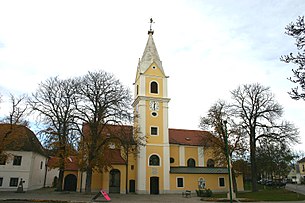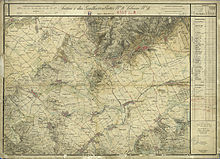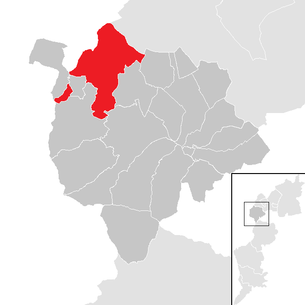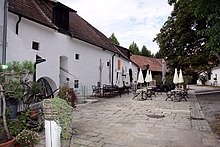Poettsching
|
market community Poettsching
|
||
|---|---|---|
| coat of arms | Austria map | |
|
|
||
| Basic data | ||
| Country: | Austria | |
| State : | Burgenland | |
| Political District : | Mattersburg | |
| License plate : | MA | |
| Surface: | 24.62 km² | |
| Coordinates : | 47 ° 48 ' N , 16 ° 22' E | |
| Height : | 218 m above sea level A. | |
| Residents : | 2,983 (January 1, 2020) | |
| Population density : | 121 inhabitants per km² | |
| Postcodes : | 7033, 7202 | |
| Community code : | 1 06 09 | |
| NUTS region | AT112 | |
| Address of the municipal administration: |
Official building 1 7033 Pöttsching |
|
| Website: | ||
| politics | ||
| Mayor : | Martin Mitteregger ( SPÖ ) | |
|
Municipal Council : ( 2017 ) (23 members) |
||
| Location of Pöttsching in the Mattersburg district | ||
 Roman Catholic Parish Church in Pöttsching |
||
| Source: Municipal data from Statistics Austria | ||
Pöttsching ( Hungarian : Pecsenyéd , Croatian : Pečva ) is a market town in the Mattersburg district in Burgenland in Austria .
geography
Pöttsching is located northwest of Mattersburg and northeast of the Rosaliengebirge . The municipality is divided into two parts: south of Bad Sauerbrunn there is an uninhabited enclave, the cadastral municipality of Pöttsching-Rosalia. The community also consists of the cadastral community Pöttsching with the village of the same name, which, in addition to the main town, also includes the settlements Hohen-Siedlung, Keltenberg, Pöttschinger See, Römersee and Scheibenwaldsiedlung.
history
Pöttsching is the oldest settlement in this area, archaeological finds date back to the Neolithic . Before the birth of Christ, the area was part of the Celtic Kingdom of Noricum and belonged to the surroundings of the Celtic hill settlement Burg on the Schwarzenbacher Burgberg . Later in the Roman Empire , the area was part of the province of Pannonia .
During the construction of a railway line from Wiener Neustadt to Sopron in 1847, the first grave sites from the early La Tène period (~ 480 to 280 BC) were discovered. The Landesmuseum Burgenland had to carry out a rescue excavation under the direction of Alois Ohrberger from 1978 to 1980 , whereby a grave field with 42 body burials - some of which were triple and quadruple - was uncovered at the Römersee . Despite recent disruptions due to tillage, a chronological sequence of burials was ascertainable. Similar to the cemetery Pottenbrunn , Loretto or Mannersdorf , for example , this resulted in an uninterrupted occupancy from the 5th to the 4th century BC. Established. The women's graves are furnished with rich grave goods, with jewelry and drinking utensils predominating. The clay pots are usually decorated with stamps, sometimes inside the bowls or on the shoulders of the bottles. A bottle with lying S-stamps in a double row is reminiscent of related pieces from the Sopron-Krautacker and Mannersdorf burial grounds . Comparative style analyzes and material investigations allow the conclusion that they come from a workshop, possibly even from a potter.

Pöttsching goes back to an old Petschenegen settlement. Around 1123 the Hungarians settled the eponymous Petschenegen , a tribe from the Black Sea region, as border guards of the Gyepű system .
Pöttsching was first mentioned as Villa Beseneu in a deed of donation in 1223 .
Like all of Burgenland, the place belonged to Hungary (German-West Hungary) until 1920/21 . Since 1898 had due to the Magyarization of the government in Budapest of Hungarian name Pecsenyéd be used.
Pöttsching became the end point of the Wiener Neustädter Canal in 1811 , which was in operation until 1879. This canal was originally intended to be led to Sopron (Ödenburg) in order to bring the coal mined at Brennberg to Vienna . The continuation failed because of the resistance of the Hungarian landowners.
The First World War demanded a relatively high blood toll among the male population of Pöttsching. A total of 80 men lost their lives, most of them on the battlefields of the East. Most of them served in only three units: the Honved Infantry Regiment 18 (33 people), the Austro-Hungarian Infantry Regiment "Freiherr von Salis-Soglio" No. 76 (24 people) and the Feldjäger Battalion 11 (8 people ). Both the Honved Infantry Regiment 18 and the Infantry Regiment 76 had Sopron as a supplementary district, while Győr was that of the military police.
The following table shows the distribution of the casualties by unit and year of war, two of the men died after the end of their wounds:
| unit | 1914 | 1915 | 1916 | 1917 | 1918 | 1919 | total |
|---|---|---|---|---|---|---|---|
| Honved Infantry Regiment 18th | 5 | 9 | 10 | 3 | 4th | 2 | 33 |
| Infantry Regiment "Freiherr von Salis-Soglio" No. 76 | 9 | 5 | 9 | 1 | 24 | ||
| Feldjäger Battalion 11 | 4th | 3 | 1 | 8th | |||
| Other units | 1 | 8th | 3 | 1 | 2 | 15th | |
| total | 19th | 25th | 23 | 5 | 6th | 2 | 80 |
After the end of the First World War , after tough negotiations, German-West Hungary was awarded to Austria in the Treaties of St. Germain and Trianon in 1919. The place has belonged to the newly founded federal state of Burgenland since 1921 (see also the history of Burgenland ). Pöttsching has been a market town since 1986 (through VO 7).
Population development

Culture and sights

- Parish church Pöttsching : The organ was built in 1792 by the Viennese organ builder Johann Gottfried Malleck . It has already changed a lot and has eleven votes.
- Atelierhaus Karl Prantl: (1990) built by the Austrian architect Ernst Hiesmayr
- Sculptures in the landscape: sculptures by international sculptors can be found on the site
- Pöttsching cultural path: the tourism project shows all the sights of the place on a hiking route in the form of an audio guide.
- In 2015, when the Neudörfl – Sopron aqueduct was being built, a 7,500 year old, well-preserved Neolithic skeleton was found in a clay pit.
politics
Municipal council
The council comprises a total of 23 members on the basis of population.
| Political party | 2017 | 2012 | 2007 | 2002 | 1997 | ||||||||||
|---|---|---|---|---|---|---|---|---|---|---|---|---|---|---|---|
| Sti. | % | M. | Sti. | % | M. | Sti. | % | M. | Sti. | % | M. | Sti. | % | M. | |
| SPÖ | 904 | 52.44 | 12 | 885 | 50.86 | 12 | 953 | 57.13 | 14th | 1062 | 64.80 | 16 | 822 | 55.06 | 12 |
| ÖVP | 646 | 37.47 | 9 | 510 | 29.31 | 7th | 610 | 36.57 | 8th | 461 | 28.13 | 6th | 435 | 29.14 | 6th |
| FPÖ | 104 | 6.03 | 1 | 113 | 6.49 | 1 | 105 | 6.29 | 1 | 116 | 7.08 | 1 | 236 | 15.81 | 3 |
| Green | 70 | 4.06 | 1 | 94 | 5.40 | 1 | not running | not running | not running | ||||||
| BIKUS | not running | 138 | 7.93 | 2 | not running | not running | not running | ||||||||
| Eligible voters | 2418 | 2368 | 2306 | 2193 | 1949 | ||||||||||
| voter turnout | 77.17% | 77.96% | 77.32% | 81.30% | 85.17% | ||||||||||
Parish council
In addition to Mayor Martin Mitteregger (SPÖ) and the two Vice Mayors Laura Moser (SPÖ) and Petra Pankl (ÖVP), the community board also includes the executive councilors Christian Knotzer (ÖVP) and Karin Lehner (SPÖ).
The community treasurer is Rudolf Linzer (SPÖ).
mayor
In the direct mayor election on October 1, 2017, Martin Mitteregger (SPÖ) was elected with 50.54% in the first ballot. His competitors were Petra Pankl (ÖVP, 43.55%) and Hermann Loidolt (FPÖ, 5.92%). Mitteregger replaced Karin Lehner (SPÖ), who took office as mayor on February 2, 2017 after Herbert Gelbmann (SPÖ), who had headed the community since 2006, resigned due to illness. Gelbmann has acted as mayor since 2006.
At the constituent meeting of the municipal council in October 2017, Laura Moser (SPÖ) and Petra Pankl (ÖVP) were elected vice mayors.
The head of office is Alexandra Rauner.
Chronicle of the mayor
Source: Atlas Burgenland
- 1923 Stefan Sauerwein ( CS )
- 1931 Anton Sauerwein (CS)
- 1934 Johann Marchart (CS)
- 1935 Johann Reisinger (CS)
- 1938 Ludwig Treuer (community administrator)
- 1945 Johann Knotzer
- 1945–1946 Alexander Stangl (SPÖ)
- 1958–1959 Heinrich Knotzer (SPÖ)
- 1959–1972 Ludwig Parise (SPÖ)
- 1972–1991 Rudolf Moser (SPÖ)
- 1991–1994 Christa Prets (SPÖ)
- 1994-2006 Irene Izmenyi (SPÖ)
- 2006–2017 Herbert Gelbmann (SPÖ)
- 2017 Karin Lehner (SPÖ) (February to October)
- since 2017 Martin Mitteregger (SPÖ)
coat of arms
Blazon : In a golden shield on a drawn-in red tip a golden church; the tip is accompanied by a red cherry twig with two leaves and three fruits (front) and a red treble clef (back).
The coat of arms was awarded on June 4, 1986. The cherry stands for fruit growing, and the clef illustrates the important role music plays in village culture. Peter Zauner , the composer of the Burgenland national anthem, also comes from Pöttsching.
Personalities
Sons and daughters of the church
- Anton David Steiger (1755–1832), mineralogist and mining pioneer
- Peter Zauner (1886–1973), musician
- Johann Reisinger (1890–1959), farmer and politician
- Heinrich Knotzer (1906–1992), farm worker, trade unionist and politician
- Ludwig Parise (1912–1991), railway employee and politician
- Karl Prantl (1923–2010), sculptor, born here and lived in Pöttsching
- Rudolf Moser (1931–2017), politician
- Christa Prets (* 1947), politician, mayor (1991) and member of the European Parliament
People related to the place
- Manfred Moser (* 1956), lawyer and politician, grew up in Pöttsching
- Katharina Prantl (* 1958), painter, grew up in Pöttsching
- Christian Sagartz (* 1981), Vice Mayor
literature
- Dominik Kimmel: The Avar burial ground from Pöttsching - Bad Sauerbrunn, Burgenland . In: Archaeologia Austriaca 81, 1997, ISSN 0003-8008 , pp. 221-246.
- Wolfgang Meyer: The weir system of Pöttsching, Mattersburg district, Burgenland . In: Festschrift for Karl Semmelweis . Burgenland Provincial Government, Provincial Archives - Provincial Library, Eisenstadt 1981, ( Burgenland Research Special Issue 6, ZDB -ID 503882-0 ), pp. 117–132.
- Susanna Steiger-Moser (Ed.): 700 years of Pöttsching parish 1299–1999 . Parish Pöttsching, Pöttsching 1999.
Web links
Individual evidence
- ^ Susanne Sievers , Otto Helmut Urban , Peter C. Ramsl: Lexicon for Celtic Archeology. A-K; L-Z . Publishing house of the Austrian Academy of Sciences , Vienna 2012, ISBN 978-3-7001-6765-5 , p. 1507 f.
- ↑ List of the fallen from Pöttsching in the First World War , website regiowiki.at, accessed on July 21, 2015
- ↑ Route and information on the Pöttsching culture trail : alpenlandmagazin.at - Pöttsching culture trail
- ↑ burgenland.orf.at sensation: 7,500 year old skeleton discovered, ORF.at, May 27, 2015.
- ↑ a b c Province of Burgenland: Election results Pöttsching 2017 (accessed on December 8, 2017)
- ↑ Province of Burgenland: Election results Pöttsching 2012 (accessed on December 8, 2017)
- ↑ Province of Burgenland: election results Pöttsching 2007 (accessed December 8, 2017)
- ↑ a b Province of Burgenland: Pöttsching 2002 election results (accessed December 8, 2017)
- ↑ a b Marktgemeinde Pöttsching: Municipal Council (accessed December 8, 2017)
- ↑ mein district.at from February 6, 2017: Karin Lehner new local chief in Pöttsching (accessed December 8, 2017)
- ↑ ORF Burgenland of February 14, 2017: Pöttsching: New "Temporary Mayor" (accessed on December 8, 2017)
- ↑ Marktgemeinde Pöttsching: Vice Mayor ( Memento of the original from October 6, 2017 in the Internet Archive ) Info: The archive link was inserted automatically and has not yet been checked. Please check the original and archive link according to the instructions and then remove this notice. (accessed December 8, 2017)
- ↑ Marktgemeinde Pöttsching: Rauner Alexandra, AR (Head of Office) (accessed December 8, 2017)
- ↑ Atlas Burgenland: Pöttsching (accessed December 8, 2017)









